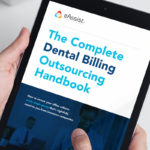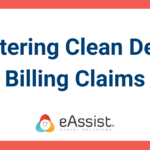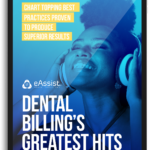Dental claims management is essential to eliminate accounts receivable issues.
What is an EOB?
An EOB stands for: Explanation of Benefits. EOBs are NOT dental claims. EOBs are sent to your office as a receipt of services rendered. Every EOB is different and unlike that same standardization that is required to submit claims, insurance companies do not standardize their EOBs. It is important to pay careful attention to the columns, verbiage, line itemizations and in general read it thoroughly and carefully.
Why should I get a breakdown of dental insurance benefits before a patient is treated?
Dental insurance benefit breakdowns do not help your dental claims processing, but rather they allow you to properly give an estimate to a patient BEFORE the treatment is started. With all the variables that come with insurance and in order to serve your patients needs best, it is vital to know their insurance coverage in detail. It is perhaps most important for the financial health of your dental practice to get insurance breakdowns. When your staff is armed with this knowledge they are able to collect more accurately at the time of service. At one time this task required many hours on the phone, but now with convenient, easy to use websites and dental software tools, this task requires less staff time. Dental insurance breakdowns continue to be one of THE most important tools in your office.
What is the importance of having the right films, charting, and photos?
Not only are films important for diagnosing treatments but they are vital in making sure that your patient’s insurance pays to the maximum benefit that it should when dental claims are processed. Depending on the type of service if films, charting or photos are not available it is possible that no payment will be issued. Films and perio charting should not be more than 1 year old, need to be readable (no cone cuts) and should be mounted properly.
What is a prosthetic replacement clause and why is it important for the office to know?
The term prosthetic means serving as or relating to a prosthesis, which dentally would refer to crowns, bridges, dentures, and partials. The prosthetic replacement specifies how often the prosthesis service can be done. A prosthetic replacement clause is generally between 5-7 years but can be as much as 12 years. It is important to know what this clause is exactly for your patient’s insurance because dental claims are denied for this. It is then equally important for your office to find out how old the prosthesis is. If a patient cannot recall an estimated range is acceptable ( example approx. 7-8 years old).
What should my patient aging report numbers be?
This number should be lower than 15% of total AR, 10% is ideal.
What should my insurance aging reports numbers be?
Over 90 should be $0, this is what we strive for.
What if the wrong tooth was billed to insurance?
It is really important to have a system of checks and balances in place so errors occur less frequently, but nothing is perfect and mistakes happen. When the wrong tooth is billed, rest at ease as this is a relatively simple fix. A letter drafted to the insurance stating the error on the dental claim and the correction will rectify the situation. It is always helpful to attach a copy of the EOB with the letter.
What do you do if the wrong code was submitted to insurance?
Similarly to the “wrong tooth billed” issue, it requires a letter to the insurance. In this letter it is really important to include what the scenario was that created the incorrect submission, as it will help avoid the suspicion of fraud. Also in the letter include the wrong code, the correct c
I thought cleanings were free?
Getting a thorough breakdown of a patients benefits is important. Included in that breakdown it is equally important to find out about frequencies and limitations. Prophies are generally covered at 100% but when your office receives an EOB back with a denial or a reduced benefit it is important to understand why and how your office could have been aware prior to the receiving the EOB. There are several reason a prophy could have been denied or reduced here are the most common reasons:
- Frequency limitation- the service was done too soon. Depending on the plan prophies can be covered;
- 2 times in a 12 month period (but be careful to understand that this does not mean 2 times in a calendar year. If a plan pays 2/12 months make sure there are NOT 3 prophies during a 12 month period otherwise INS will deny for frequency.
- 1 time every 6 months TO THE DAY!! Prophies cannot be even 1 day closer than 6 months apart otherwise insurance will deny coverage
- 2 times in a single benefit or calendar year. (know the difference between calendar year and benefit year)
- Patient Reached Yearly Max- in most cases if the maximum has been reached even preventative services will be denied, as they are part of the yearly maximum benefit.
Please explain the dental deductible?
There can be different types of deductibles (preventative, basic and major) most insurance companies have a deductible that is waived on preventive care, HOWEVER, there are always some that don’t. Deductibles vary ranging from (usually) 25-100. A deductible is to be paid by the patient before any services are considered for payment. Knowing what your patient’s deductible is will help you to collect the right amount of money at the time services are rendered. This is a key to ensure that your accounts receivables are low. Once dental claims are processed, it is very difficult to collect “extra” money owed by the patient because of a miscalculation of the deductible at the time of service.
What is the formula for calculating a deductible and patient portion?
Total charge- deductible * % of patient cost + deductible= total amount payable by the patient. Example: $175 filling with a deductible of $50.00 and patient pays 20% of basic services would look like this
$175.00-$50.00= $125.00 *.20=$25.00+$50.00= $75.00 total patient cost.
Why did insurance pay less than the % quoted on the benefit breakdown?
In most cases this has occurred because your office is not a participating provider for the insurance billed and they have paid off of what they (the insurance company) considers UCR fee. The patient is responsible for the difference. Improper dental claims management can create upset patients that leave your practice. It is imperative that you get these initial treatment estimates correct before the treatment is completed.
What does UCR mean?
UCR stands for Usual, Customary and Reasonable.






